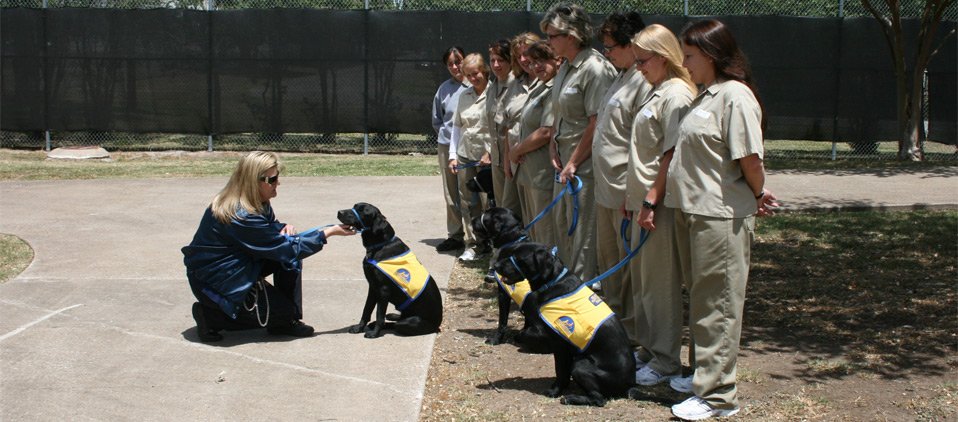Have you ever heard the heartwarming story of a hardened inmate breaking into tears at the gentle touch of a wagging tail? It sounds like something out of a movie, but it’s happening in prisons all over the world. Therapy dogs, with their boundless affection and nonjudgmental spirit, are quietly transforming lives behind bars. Their presence brings hope where there was despair, laughter where there was silence, and healing where there was pain. The idea that a simple dog could be a catalyst for profound change is as surprising as it is inspiring. Let’s dive into the world of therapy dogs in prisons and discover how these four-legged companions are rewriting the rules of rehabilitation.
The Surprising Science Behind Therapy Dogs

It might seem almost magical, but the positive effects of therapy dogs are backed by real science. Research shows that interacting with dogs can lower blood pressure, reduce stress hormones, and boost feel-good chemicals like oxytocin. In the tough, high-stress environment of prison, these benefits are magnified. When inmates pet or play with dogs, their bodies physically relax, and their minds lighten. It’s like hitting a “pause” button on daily worries. The science tells us that this isn’t just “puppy love”—it’s a powerful tool for emotional healing. Even skeptics are turning into believers when they see hardened inmates smile and soften in the presence of a friendly dog.
Building Trust Where Hope Is Scarce

Trust can be hard to come by in prison. Many inmates arrive with years of betrayal and disappointment, making it difficult to open up to others. Enter the therapy dog, tail wagging and eyes full of trust. Dogs don’t care about the past; they respond to kindness in the present moment. This unconditional acceptance helps break down emotional barriers. Inmates often share that dogs become their first source of trust in years, sometimes decades. It’s no exaggeration to say that a therapy dog’s trust can spark a ripple effect, encouraging inmates to build healthier, more trusting relationships with each other and even with staff.
Teaching Responsibility and Empathy

Looking after a dog is no small task, and in prison, it’s a big responsibility. Inmates involved with therapy dog programs are often in charge of feeding, grooming, and exercising the dogs. These simple daily routines teach important life skills—discipline, patience, and empathy. It’s not just about the dog; it’s about learning to care for another living being. Many participants say they never realized how much a dog’s well-being would mean to them. This sense of responsibility often carries over into other parts of their lives, helping them become more reliable and compassionate individuals.
Reducing Tension and Conflict
Prisons can be tense, sometimes volatile places. But when a dog enters the room, something remarkable happens: the mood shifts. Guards and inmates alike report that therapy dogs are natural peacemakers. Their calming presence helps defuse arguments and reduce aggression. It’s hard to stay angry or anxious when a friendly dog is nudging your hand for a scratch. The simple act of being around a dog can lower everyone’s guard, making it easier to resolve conflicts peacefully. This ripple of calm can make the entire facility a safer, more positive place for everyone.
Boosting Mental Health and Reducing Loneliness

Loneliness and depression are major challenges for people in prison. Therapy dogs offer a warm, loving presence that cuts through isolation. For many inmates, these visits are the highlight of their week. The dogs listen without judgment and provide genuine affection—a rare gift in such a harsh environment. Over time, participants in therapy dog programs report fewer feelings of anxiety and depression. Many say that the dogs give them a reason to look forward to tomorrow, helping them find hope in the midst of difficult circumstances.
Creating Opportunities for Rehabilitation

Rehabilitation is about more than serving time; it’s about learning new ways to live. Therapy dog programs often serve as stepping stones to other opportunities, such as education, work training, or counseling. Inmates who participate in these programs are more likely to engage in further rehabilitation efforts. The sense of accomplishment from caring for a dog often inspires them to set and achieve bigger goals. Some even go on to train service dogs for people with disabilities, turning their experience into a lifelong passion and a way to give back to the community.
Forging Unlikely Friendships

Perhaps one of the most heartwarming results of therapy dog programs is the way they bring people together. Inmates from different backgrounds and even rival groups find common ground through their shared love for the dogs. The dogs don’t judge by history or reputation—they see everyone as a potential friend. This can break down social barriers and foster unexpected friendships. Laughter becomes more common, and the atmosphere softens. The simple act of tossing a ball for a dog can lead to conversations, cooperation, and genuine human connection.
The Journey Doesn’t End at the Prison Gates

The impact of therapy dogs doesn’t stop when inmates are released. Many former participants say that the lessons they learned from working with dogs stay with them long after they leave prison. They carry forward a new sense of empathy, responsibility, and hope. Some even credit therapy dogs with helping them reconnect with families and rebuild their lives. The story of therapy dogs in prisons isn’t just about second chances for people—it’s about the lasting bonds and life-changing lessons that only a dog can teach.






